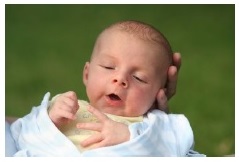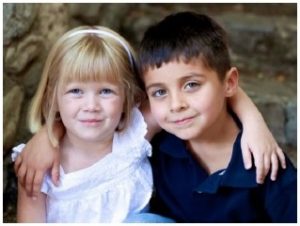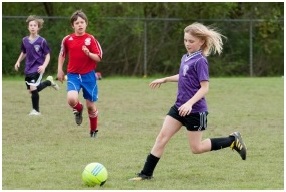The Seven Developmental Stages
BODYNAMICS STARTS FROM the premise that Mutual Connection – (When I am all of me, and you are all of you, can we be in deep connection?) – is the basic drive of development and growth. Our empirical research has shown that there are a series of basic themes around which connection, bonding, and attachment occur. This has led to the Bodynamic model of Seven Developmental Stages. Our clinical experience shows that disturbances in the primary childhood connections in relation to these themes lead to developmental or in some cases traumatic distortions.
WE DISTINGUISH THREE possible outcomes for each developmental stage and its theme. If the parenting is “good enough”, the child will be able to be herself, be in deep relationship, and develop the skills appropriate to that stage (our “resourced” position). If there are severe or early disturbances in a given stage, there will be a tendency to give up the impulse to do and feel things. Abilities and insights will tend to go unlearned or be given up, appearing in the adult to be outside of awareness or missing. (our “early” position). This is the origin of psychological resignation. If the disturbances are less severe of later in the stage, there will be a tendency to hold back impulses to do or feel things, or they may be enacted rigidly (our “late” position). Both early and late positions result in a distortion of self and relationship (of Mutual Connection)
THE SEVEN DEVELOPMENTAL STAGES are named for the main issue or theme dealt with in that stage. Listed in the order of increasing age they are: Existence, Need, Autonomy, Will, Love/Sexuality, Opinion and Solidarity/Performance. For example, the Will Stage, 2 to 4 years of age, has major theme of “Can I be focused, powerful, and expressive, make my own decisions, and still be accepted by my family?” The early position of the Will Stage is characterized by self-sacrificing, the late position by judging, and the resourced position by assertiveness. With this detailed information a therapist can pinpoint the developmental origins of specific issues current in a client’s life. Interventions thus become more precise and age appropriate. This work with developmental issues is complemented, when called for, by the sophisticated Bodynamic approach to working with shock trama or PTSD.
For a more detailed overview of the Seven Developmental Stages and Splits please visit:
Seven Developmental Stages overview and the character types that emerge from each stage
1. Existence (womb – 3 months): where a basic imprint of one’s right to exist and sense of being alive is formed, from womb life, birth and early infancy. In an adult, the disruptions from this stage can manifest as either a withdrawal from connection and a strong mental life, or as an anxiousness about possible loss of connection to others and a strong emotional energy.
2. Need (1 month – 18 months): where the infant’s experience of having core satisfaction of basic needs is established in the relationship with the parents, leading to the beginning of self-regulation. In an adult, the disruptions from this stage can manifest either as a despairing or distrustful attitude about being able to get you needs met, and not being aware of what your needs are or how to sense satisfaction.
3. Autonomy (8 months – 2 years, 6 months): The child’s curiosity and life force moves them to explore the world through an explosion of psychomotor skills. An imprint of the child’s impulses toward autonomy is formed. In an adult, the disruptions from this stage can lead to a lack of awareness of one’s own impulses and feelings, or to a fear of having to give up one’s impulses and feelings in order to be in relationship, leading to the avoiding of commitments.
4. Will (2 – 4 years): The child’s at this age becomes able to separate her thinking, intentions, and actions; to make choices and put all her power into her action. In an adult, the disruptions from this stage can lead to either acting from a self-sacrificing position and having difficulties in planning, or holding back power and appearing angry, while believing that if there is a problem it is someone else’s fault.
5. Love/Sexuality (3 – 6 years): Where the child learns to love in a romantic way and learns to integrate heart and sexual feelings. In an adult, the disruptions from this stage can lead to a split between loving and sexual feelings, and a romantic or seductive way of being in relationship.
6. Opinion Forming (5 – 9 years): The child learns to put himself, his center into words, and learns to deal with rules, norms and culture. In an adult, the disruptions from this stage can lead to either difficulty in forming and expressing opinions, or having rigid opinions and rejecting those of others.
7. Solidarity/Performance (7 – 12 years): Where the child finds a place in their culture by learning how to be a member of group and community. This is also a time of acquiring and mastering high level skills. In an adult, the disruptions from this stage can lead to a fear of competing or standing out in a group (leveling), or a need to be the star in any group in spite of the consequences for oneself or the group (competing).

Comparing Freud, Erikson & Lowen Character Structures to Bodynamics

Healthy(Resourced) Character Positions
1. Existence Structure – Secure Being: Happy to Exist
As a child, she felt wanted, accepted, protected, and secure. As she grows up, she has a lust for life, and can integrate thoughts and feelings. Her energy moves freely in her body, and her head and body are experienced as a coherent wholeness. She enjoys contact and enjoys being alone. She has integrated creativity and sensitivity with emotional energy and presence.
2. Need Structure – Satisfying: Feeling Secure that their needs will be met
As an adult, a person that is resourced will have a sense of what they need, and also how to act to satisfy that need: i.e., I’m hungry, I need to eat; or, I’m full, I want to stop eating. The adult body will have soft, contactful, eyes. They will hold their head and spine in an erect way. Their lips will be full, and they will be comfortable reaching out for their needs as well as taking in. They will enter into intimate relationships with an expectation and belief that they can express their needs to those close to them, and often enough receive a caring response. They also will be happy to reciprocate with that person’s requests for help, and will have a sense that this will mutually deepen the closeness between them.
3. Autonomy Structure – Emotionally autonomous: Curious & excited to explore
A person acting from a healthy or resourced Autonomy position can sense, feel, and act on his own impulses. He has experienced that his involvement and activities will be encouraged and supported. He can accept help when he needs it, and can also follow another person’s lead. His upper and lower body are equally energized and energy moves freely between them. He can give and receive from his core. He can sense how much energy he has to give, and when to stop . He can balance his own impulses, and feelings/desires against other’s expectations. He can be helpful, charming, and outgoing.
4. Will Structure – Assertive: Determination, Power, and Persistence
A resourced person’s back and shoulders are straight and unburdened, and the shoulders and buttocks are full and energized. They have a lot of energy that they can choose to put behind their intentions, decisions and actions in the world. The person is able to use all their power while still being considerate of others. They can be altruistic, but they are aware of their own limits and of taking on burdens. They can follow suggestions without feeling a loss of freedom. They can act freely and assertively with others and in groups, giving and receiving help. They are able to plan well, with time for unforeseen events. They can be devoted, patient, critical, and humorous without being sarcastic.
5. Love/Sexuality Structure – Balancing heart and sexuality: Enjoys both Loving and Sexual Intimacy
A person acting from the healthy or resourced Love/Sexuality position feels valued and respected for her loving and sensual/ sexual feelings and behavior. She senses both of these and decides how to act on them. Her muscular coordination is free and well-integrated. Her pelvis is centered, and not rotated forward or back. She can enjoy flirting or being seductive, and does so responsibly. She can be loving or sexual with another person, or both. She can accept refusal or rejection. She responds clearheadedly to the overtures of others. She avoids triangulation and does not unconsciously take sides in other people’s conflicts.
6. Opinion Structure – Opinion-embodying: Know what they think and are open to what others think
A person with a healthy Opinion Structure understands that opinions are only based on what you presently know, and are not necessarily truth; they can be challenged and changed when you get new information. She understands and accepts that social norms and values vary according to the situation or place. She treats people so they feel equal and included. Her movements are becoming more refined and she enjoys running, skipping, and jumping.
7. Solidarity/Performance Structure – Balancing self and group: Secure in leading, Excelling, or being a member of a group
He is able to establish a positive sense of himself in a group and feel deeply a part of a group. He gains value by being able to move between doing his best and helping others to be their best, and between leading or going along with and supporting the group and others, as needed.
He can give his best and also accept when he fails or when another is better. He is comfortable doing what is needed by his group, and is able to recognize other peoples’ skills and support them if they need assistance. Physically the healthy person has a straight back, an erect posture, and flexible and fluid movements. He enjoys using and developing his physical and mental skills and will practice repeatedly to improve his abilities.







